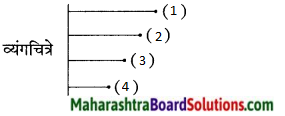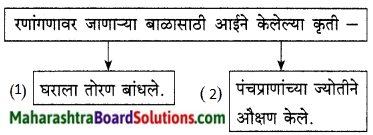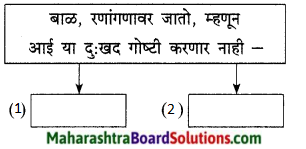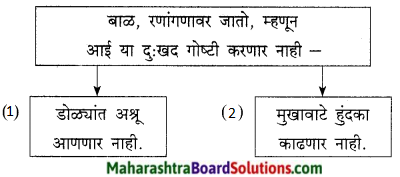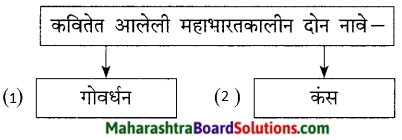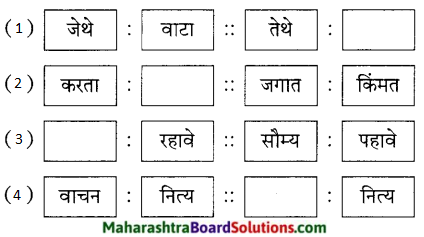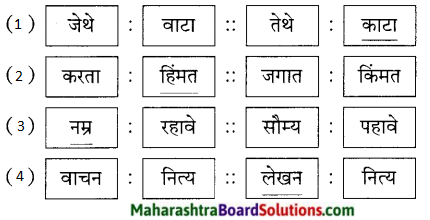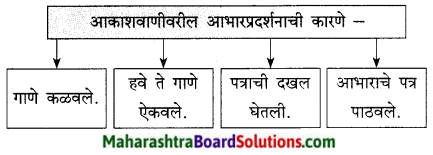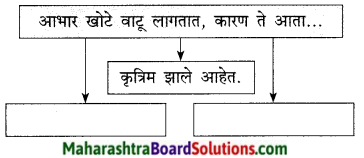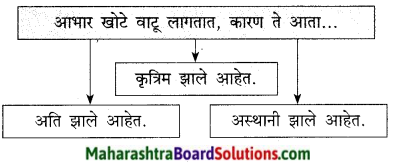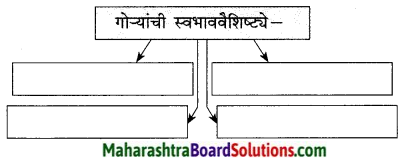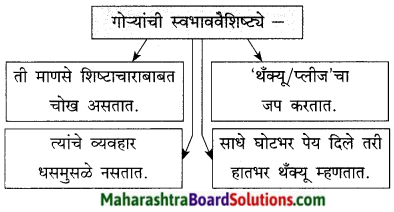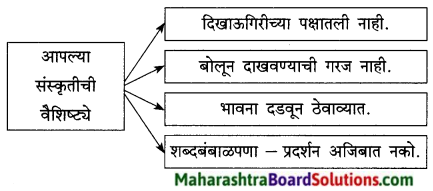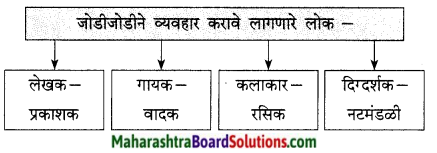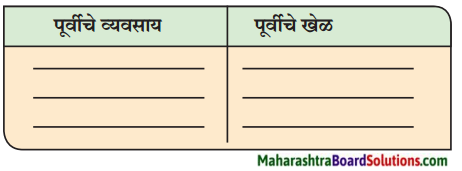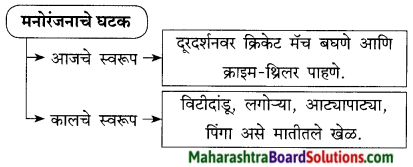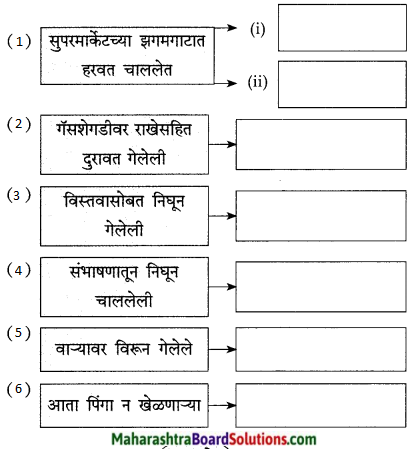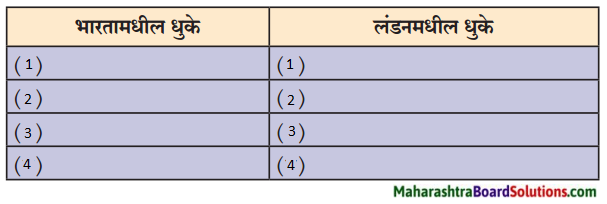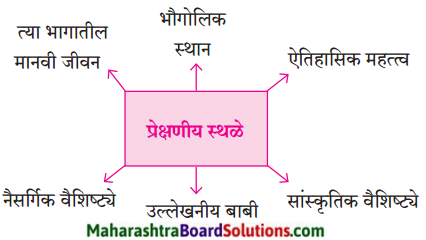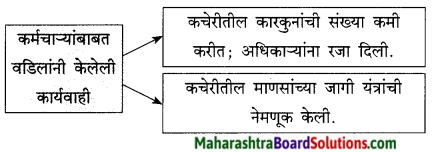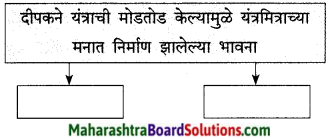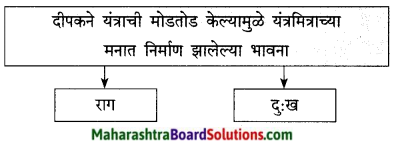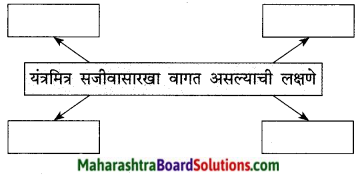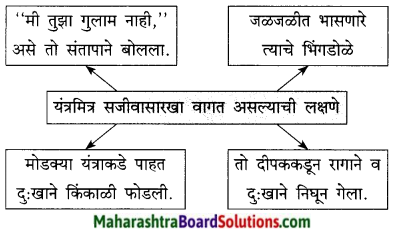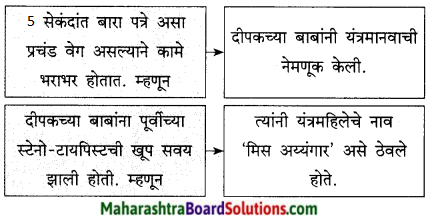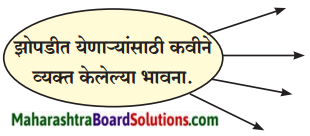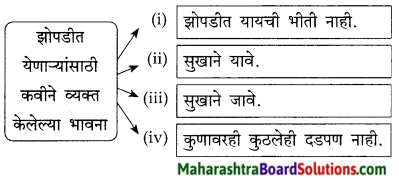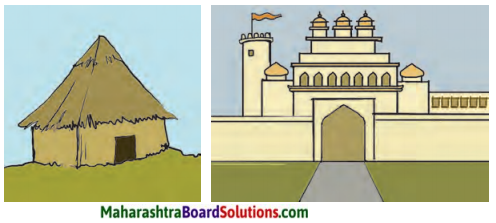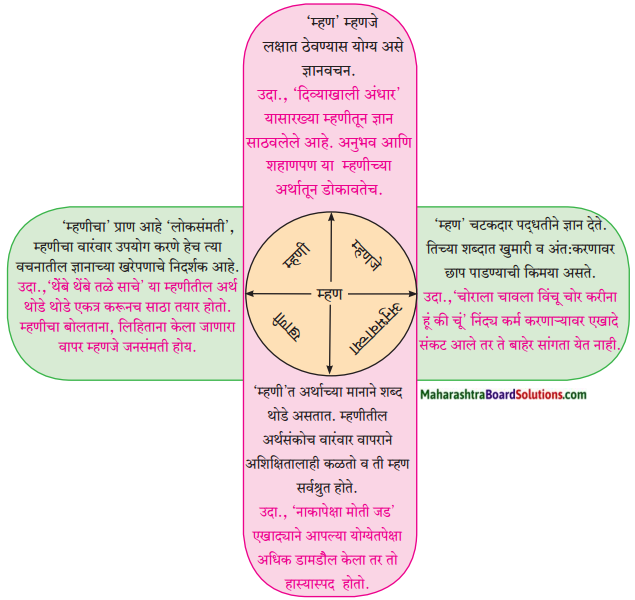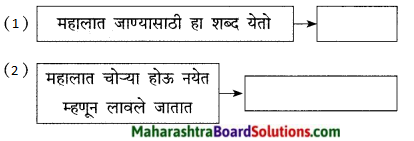Balbharti Maharashtra State Board Class 9 Marathi Solutions Kumarbharti Chapter 16 वनवासी Notes, Textbook Exercise Important Questions and Answers.
Maharashtra State Board Class 9 Marathi Kumarbharti Solutions Chapter 16 वनवासी
9th Std Marathi Kumarbharati Digest Chapter 16 वनवासी Textbook Questions and Answers
1. खालील शब्दसमूहातील अर्थ स्पष्ट करा:
प्रश्न 1.
खालील शब्दसमूहातील अर्थ स्पष्ट करा:
- पांघरू आभाळ – [ ]
- वांदार नळीचे – [ ]
- आभाळ पेलीत – [ ]
उत्तर:
- उघड्यावर संसार आहे
- डोंगराच्या घळीत वानरे असतात, तिथे वास्तव्य
- ऊन, वारा, पाऊस यांचा सामना करीत
![]()
2. शोध घ्या:
प्रश्न 1.
शोध घ्या:
(अ) ‘हात लाऊन गंगना येऊ चांदण्या घेऊन’ या काव्यपंक्तीत व्यक्त होणारा आदिवासींचा गुण – [ ]
(आ) कवितेच्या यमकरचनेतील वेगळेपण – [ ]
उत्तर:
(अ) अतुलनीय धैर्य व उत्तुंग इच्छाशक्ती
(आ) प्रत्येक कडव्यातील चार पंक्तींमधील पहिल्या, दुसऱ्या व चौथ्या पंक्तींचे यमक जुळते.
उदा., भाकर – भोकर – ढेकर / वेगानं – यंगून – घेऊन
3. काव्यसौंदर्य:
प्रश्न 1.
‘बसू सूर्याचं रुसून, पहू चंद्राकं हसून, ‘ या काव्यपंक्तीतील भावसौंदर्य स्पष्ट करा.
उत्तर:
दुपारी सूर्य तापतो. माळरानावर हुंदडणाऱ्या आदिवासी मुलांना कडक उन्हात खेळावे लागते. उघड्याबोडक्या असलेल्या मुलांना या उन्हाचा त्रास होतो; म्हणून ते सूर्यावर रुसून बसतात. रात्री चंद्र उगवतो. त्या शीतल चंद्रप्रकाशात आदिवासी मुलांच्या बागडण्याला उधाण येते; म्हणून चंद्राकडे बघून ते आनंदाने हसतात. सूर्यचंद्राचे त्यांच्याशी असलेले अनोखे नाते या ओळींतून प्रकट झाले आहे.
प्रश्न 2.
‘डोई आभाळ पेलीत, चालू शिंव्हाच्या चालीत,’ या पंक्तींत कवीला अभिप्रेत असलेला अर्थ लिहा.
उत्तर:
आदिवासी मुले उघड्याबोडक्या अंगाने उंबराच्या माळावर भटकतात, बागडतात. झाड्याकड्यांवर त्यांचा वावर असतो. त्यांचे जीवन खडतर असते. परंतु त्यांना या कष्टमय जीवनाची फिकीर नसते. ऊन, वारा, पाऊस झेलत ती मजेत राहतात. जणू ते आपल्या माथ्यावर सर्व आभाळ पेलतात. सिंह जंगलाचा राजा असतो. त्याचा दरारा सगळ्या रानावर असलो; म्हणून आदिवासी मुले सिंहाच्या दमदार चालीने चालत सारी संकटे झेलतात. आदिवासी मुलांच्या चिवट वृत्तीचे व धाडसाचे वर्णन कवींनी केले आहे.
4. अभिव्यक्ती.
प्रश्न 1.
‘आदिवासी समाज आणि जंगल यांचे अतूट नाते असते,’ याविषयी तुमचे विचार लिहा.
उत्तर:
आदिवासी समाज हा दाट जंगलात व कडेकपारीत राहतो. झाडांच्या वाळलेल्या फांदया, काटक्या घेऊन त्यांची खोपटी (झोपडी) तयार होते. रानातली फळे, कंदमुळे खाऊन ते गुजराण करतात. ओढ्यानाल्याचे पाणी पितात. निसर्गात ते उघड्यावर जगतात. ते धरतीवर जणू आभाळ पांघरून जगतात. जंगलातील पशुपक्षी त्यांचा मित्रपरिवार असतो. दुखण्याखुपण्याला ते झाडपाल्यांचेच औषध वापरतात. आदिवासी समाजाचे सारे जीवन जंगलावर अवलंबून असते; म्हणून आदिवासी समाज व जंगल यांचे नाते अतूट असते.
![]()
भाषा सौंदर्य:
लिखित मजकुरासाठी योग्य विरामचिन्हांचा वापर महत्त्वपूर्ण असतो. विरामचिन्हांच्या चुकीच्या वापरामुळे संपूर्ण वाक्याचा अर्थ बदलू शकतो व भाषेचा बाजही बिघडू शकतो. भाषा योग्य स्वरूपात अर्थवाही होण्यासाठी विरामचिन्हांच्या योग्य वापराचा अभ्यास व सराव होणे आवश्यक आहे.
प्रश्न 1.
खालील वाक्यांत योग्य विरामचिन्हे वापरून वाक्ये पुन्हा लिहा :
- ते बांधकाम कसलं आहे
- आकाशकंदील पूर्ण झाल्यावर दादांनी तो खांबावरच्या खिळ्याला टांगला
- गुलाब जास्वंद मोगरा ही माझी आवडती फुले आहेत
- अरेरे त्याच्याबाबतीत फारच वाईट झाले
- आई म्हणाली सोनम चल लवकर उशीर होत आहे
उत्तर:
- ते बांधकाम कसलं आहे?
- आकाशकंदील पूर्ण झाल्यावर दादांनी तो खांबावरच्या खिळ्याला टांगला.
- गुलाब, जास्वंद, मोगरा ही माझी आवडती फुले आहेत.
- अरेरे! त्याच्याबाबतीत फारच वाईट झाले!
- आई म्हणाली, “सोनम, चल लवकर. उशीर होत आहे.”
Marathi Kumarbharati Textbook Std 9 Answers Chapter 16 वनवासी Additional Important Questions and Answers
1. पुढील कवितेच्या आधारे दिलेल्या सूचनांनुसार कृती करा:
कृती 1 : (आकलन)
प्रश्न 1.
आकृतिबंध पूर्ण करा:
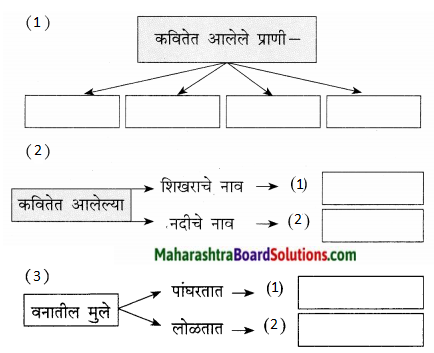
उत्तर:

![]()
प्रश्न 2.
पुढीलपैकी सत्य विधान ओळखून लिहा:
1. आदिवासी मुलांचे गाव कळसूबाईच्या पलीकडे आहे.
2. आदिवासी मुलांचे गाव आभाळाच्या पलीकडे आहे.
3. आदिवासी मुलांचे गाव ओढ्याच्या पलीकडे आहे.
4. आदिवासी मुलांचे गाव प्रवरा नदीच्या पलीकडे आहे.
उत्तर:
सत्य विधान : आदिवासी मुलांचे गाव ओढ्याच्या पलीकडे आहे.
प्रश्न 3.
आकृती पूर्ण करा:
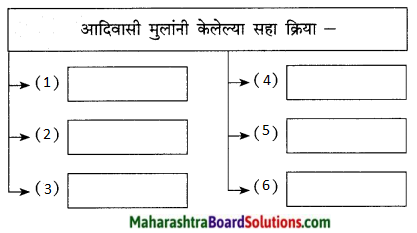
उत्तर:
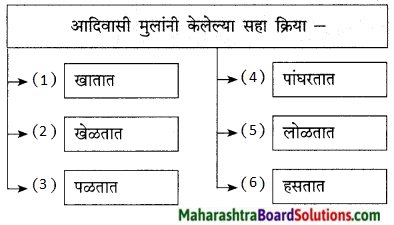
| आम्ही डोंगरराजाची पोन्हं कळसू आईची आम्ही उघडी बोडकी बाळं परवरा माईची. | बसू सूर्याचं रुसून पहू चंद्राकं हसून बोलू बाज तिकिड्याशी नाचू घोंगडी नेसून. |
| घेऊ हातावं भाकर वर भाजीला भोकर खाऊ खडकावं बसून देऊ खुशीत ढेकर. | डोई आभाळ पेलीत चालू शिंव्हाच्या चालीत हिंडू झाडा-कड्यांवरी बोलू पक्ष्यांच्या बोलीत. |
| खेळू टेकडी भवती पळू वाऱ्याच्या संगती वर पांघरू आभाळ लोळू पृथ्वीवरती. | आम्ही सस्याच्या वेगानं जाऊ डोंगर यंगून हात लाऊन गंगना येऊ चांदण्या घेऊन. |
| आम्ही वाघाच्या लवणाचे आम्ही वांदार नळीचे गाव वहाळापल्याड आम्ही उंबर माळीचे. |
कृती 2 : (आकलन)
1. योग्य पर्याय निवडून विधाने पूर्ण करा:
प्रश्न 1.
आदिवासी मुले खडकावर बसून खातात व आनंदाने ……………………
(य) भोकर देतात
(र) ढेकर देतात
(ल) उड्या मारतात
(व) नदीत डुंबतात
उत्तर:
1. आदिवासी मुले खडकावर बसून खातात व आनंदाने ढेकर देतात.
![]()
प्रश्न 2.
आदिवासी मुले हिंडतात ती …………………
(य) डोंगरमाथ्यावर
(र) वाऱ्याबरोबर
(ल) उंबर माळीवर
(व) झाडांवर व कड्यांवर
उत्तर:
1. आदिवासी मुले हिंडतात ती झाडांवर व कड्यांवर.
2. चौकटी पूर्ण करा:
प्रश्न 1.
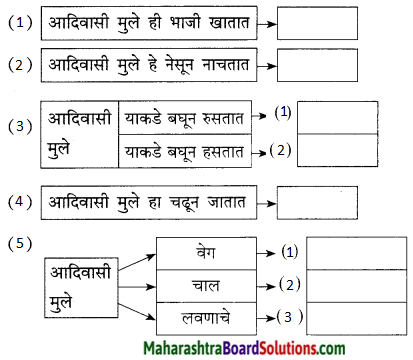
उत्तर:

कृती 3 : (दोन ओळींचा सरळ अर्थ)
प्रश्न 1.
घेऊ हातावं भाकर वर भाजीला भोकर
खाऊ खडकावं बसून देऊ खुशीत ढेकर
उत्तर:
प्रवरा नदीची बाळे म्हणतात-आम्ही हातात भाकरी घेतो, त्यावर भोकरीच्या पाल्याची भाजी ठेवतो आणि शांतपणे खडकावर बसून पोटभर भाजीभाकरी खाऊन तृप्तपणे ढेकर देतो.
![]()
1. पुढील कवितेवर दिलेल्या मुद्द्यांच्या आधारे कृती सोडवा:
प्रश्न 1.
कविता – वनवासी.
उत्तर:
वनवासी
1. प्रस्तुत कवितेचे कवी/कवयित्री → तुकाराम धांडे.
2. कवितेचा विषय → कळसूबाई शिखराच्या पायथ्याशी प्रवरा नदीच्या खोऱ्यातील आदिवासी जीवनाचे वास्तव चित्रण आदिवासी बोलीत करणे, हा कवितेचा विषय आहे.
3. कवितेतील दोन शब्दांचे अर्थ →
- डोंगर = पर्वत
- खडक = दगड
- आभाळ = आकाश
- पृथ्वी = अवनी
- वाघ = व्याघ्र
- सूर्य = रवी
- चंद्र = शशी
- बोली = भाषा.
4. कवितेतून मिळणारा संदेश → आपल्या सभोवती निसर्गात जगणाऱ्या मानवांच्या जीवनशैलीचा परिचय व्हावा व त्यांच्या जगण्याशी आपण समरस होऊन सह-अनुभूती घ्यावी, हे उद्दिष्ट या कवितेचे आहे.
5. कवितेची भाषिक वैशिष्ट्ये → सैल अष्टाक्षरी छंदात ही कविता आहे. ग्रामीण बोलीभाषेतील जिवंत चैतन्य या कवितेच्या शब्दकळेत भारलेले दिसते. कळसूआई व प्रवरामाई यांची ही बाळे, हातात भाकरी-भाजी घेऊन खडकावर बसून खाणारी ही मुले, वाऱ्याच्या संगतीत खेळणारी व आभाळ पांघरणारी, सूर्याचंद्राशी बोलणारी आणि पक्ष्यांची बोली कंठात असणारी व चांदण्या हातात आणण्याची जिद्द असणारी ही पोरे-या सर्व नवीन व ताज्या प्रतिमांनी ही कविता सजलेली आहे. सहज जीवनशैलीची सहज भाषा उत्कटपणे कवींनी कवितेत मांडली आहे. वाघाचे लवण, वांदार नळी, उंबरमाळी, तिकिड्या हे नक्षत्र असल्या अपरिचित पण जिवंत संकल्पना नव्याने कवितेत आल्या आहेत.
6. कवितेतून व्यक्त होणारा विचार → वनामध्ये राहणारी आदिवासी मुले व त्यांची उत्साही वृत्ती यांचे दर्शन या कवितेतून घडते. ।
7. कवितेतील दोन ओळींचा सरळ अर्थ:
आम्ही सस्याच्या वेगानं
जाऊ डोंगर यंगून
हात लावून गंगना
येऊ चांदण्या घेऊन!
→ आम्ही सशाच्या गतीने डोंगर चढून जातो. आकाशाला हात लावून चांदण्या घेऊन येतो. निसर्गात राहताना आम्हांला अनोखा आनंद होतो.
8. कविता आवडण्याची वा न आवडण्याची कारणे → आदिवासी लेकरांचे अनोखे भावविश्व या कवितेत मांडले आहे. डोंगरदऱ्यांत, उघड्या निसर्गात मुक्तपणे, निर्भयपणे निसर्गाचेच घटक होऊन राहणारी ही वनवासी मुले कशी जगतात, याचे प्रत्ययकारी चित्रण करणारी ही कविता आहे. संवेदनशील मनाला भावेल, असे वेगळे जीवनदर्शन व वेगळी जीवनदृष्टी देणारी ही कविता असल्यामुळे ग्रामीण बोलीतील ही सहजसुंदर कविता मला आवडली.
![]()
1. पुढील ओळींचे रसग्रहण तुमच्या शब्दांत करा:
प्रश्न 1.
‘आम्ही डोंगरराजाची
पोहं कळसू आईची
आम्ही उघडी बोडकी
बाळं परवरा माईची’
उत्तर:
आशयसौंदर्य: सह्याद्रीच्या डोंगररांगांतील कळसूबाई शिखराच्या पायथ्याशी प्रवरा नदीच्या खोऱ्यातील आदिवासी जीवनाचे वास्तव चित्रण कवी तुकाराम धांडे यांनी ‘वनवासी’ या कवितेत केले आहे. डोंगरदऱ्यांत आनंदाने व मुक्तपणे नैसर्गिक जीवन जगणाऱ्या वनवासी मुलांच्या भावनांचे चित्रण करणे हा या कवितेचा आशय आहे.
काव्यसौंदर्य: डोंगरदऱ्यांत, उघड्या निसर्गात मुक्तपणे व निर्भयपणे निसर्गाचेच घटक होऊन राहणाऱ्या वनवासी लेकरांचे अनोखे विश्व उपरोक्त ओळींमध्ये साकारले आहे. निसर्गातील वन्य प्राण्यांप्रमाणे जगणारी ही मुले आत्मविश्वासाने सांगतात की, डोंगर आमचा राजा आहे. आम्ही डोंगरराजाची मुले आहोत. कळसूबाई शिखराच्या भवतालचा प्रदेश आमची आई आहे. उघडीबोडकी स्वच्छंदपणे बागडणारी आम्ही प्रवरा नदीची बाळे आहोत. भयमुक्तता व नैसर्गिक जीवनाची ओढ या भावनांचे चित्रण उपरोक्त ओळींत केले आहे.
भाषिक वैशिष्ट्ये: सैल अष्टाक्षरी छंदात ही कविता आहे. ग्रामीण बोलीभाषेतील जिवंत चैतन्य या कवितेच्या शब्दकळेत भारलेले दिसते. कळसूआई व प्रवरामाई यांची ही बाळे, हातात भाकरी-भाजी घेऊन खडकावर बसून खाणारी ही मुले, वाऱ्याच्या संगतीत खेळणारी व आभाळ पांघरणारी, सूर्याचंद्राशी बोलणारी आणि पक्ष्यांची बोली कंठात असणारी व चांदण्या हातात आणण्याची जिद्द असणारी ही पोरे – या सर्व नवीन व ताज्या प्रतिमांनी ही कविता सजलेली आहे. सहज जीवनशैलीची सहज भाषा उत्कटपणे कवींनी कवितेत मांडली आहे. वाघाचे लवण, वांदार नळी, उंबरमाळी, तिकिड्या हे नक्षत्र असल्या अपरिचित पण जिवंत संकल्पना नव्याने कवितेत आल्या आहेत.
भाषाभ्यास:
(आ) भाषिक घटकांवर आधारित कृती:
प्रश्न 1.
शब्दसंपत्ती:
- अनेकवचन लिहा:
- चांदणी
- पक्षी
- टेकडी
- डोंगर.
उत्तर:
- चांदणी – चांदण्या
- पक्षी – पक्षी
- टेकडी – टेकड्या
- डोंगर – डोंगर.
![]()
प्रश्न 2.
स्त्रीलिंगी रूपे लिहा:
- वाघ
- ससा
- सिंह
- वानर.
उत्तर:
- वाघ – वाघीण
- ससा – सशीण
- सिंह – सिंहीण
- वानर – वानरी.
प्रश्न 3.
जोडशब्दांचे सहसंबंध लावा: (डोंगर उघडी झाडे ) कडे )
( झुडपे ) कपारी) दऱ्या बोडकी )
उत्तर:
- डोंगर-दऱ्या
- उघडी-बोडकी
- झाडे-झुडपे
- कडे-कपारी
2. लेखननियम:
प्रश्न 1.
गटातील अचूक शब्द ओळखा:
1. खुषीथ, खूशीत, खुशीत, खूषीत.
2. घोगंडी, घोंगडी, घोंगडि, घोगडि.
उत्तर:
1. खुशीत
2. घोंगडी.
![]()
4. पारिभाषिक शब्द:
प्रश्न 1.
योग्य पर्याय निवडा:
1. Clerk –
- अभियंता
- समावेशक
- लिपिक
- सहअध्यायी.
उत्तर:
3. लिपिक
प्रश्न 2.
Agent –
- अवांतर
- प्रतिनिधी
- हस्तक
- उपयोगी.
उत्तर:
2. प्रतिनिधी.
वनवासी Summary in Marathi
कवितेचा आशय:
वनामध्ये राहणारी आदिवासी मुले, त्यांचे जीवन, त्यांचे खेळ, खाणे-पिणे व त्यांची उत्साही वृत्ती यांचे मनोहारी वर्णन या कवितेत ग्रामीण शब्दकळेत केले आहे.
![]()
शब्दार्थ:
- वनवासी – रानांमध्ये राहणारे.
- पोहं – पोरे.
- उघडी बोडकी – अंगावर वस्त्र नसलेली.
- माई – आई (मोठी बहीण).
- हातावं – हातावर.
- खडकावं – दगडावर.
- वांदार – वानर, माकडे.
- वहाळ – ओहळ, ओढा, नाला.
- पल्याड – पलीकडे.
- माळीचे – माळरानावरचे.
- पहू – बघू.
- चंद्राकं – चंद्राकडे.
- बाज – शोभा.
- पेलीत – झेलीत.
- शिंव्ह – सिंह.
- चालीत – चालण्याची ढब.
- सस्या – ससा.
- यंगून – चढून.
- गंगना – आकाशाला.
टिपा:
- कळसू – भंडारदरा (नाशिक-घोटी) येथे असलेले सह्याद्रीचे सर्वांत उंच शिखर, कळसूबाईचे शिखर.
- परवरा माई – प्रवरा नदी ही माई आहे.
- भोकर – एक रान-वनस्पती. याच्या झाडपाल्याची व फळांची भाजी करतात.
- ढेकर – पोट भरल्यावर पोटातून ओठावर येणारा आवाज.
- वाघाचे लवण – डोंगरामधली खळगीची जागा, जिथे वाघ वस्ती करतात.
- वांदार नळी – डोंगरपठारावरची जागा, जिथे माकडे मोठ्या प्रमाणात असतात.
- उंबर माळ – जिथे उंबराची झाडे मोठ्या प्रमाणात असतात, ते माळरान.
- बाज तिकिडा – आकाशातील तीन नक्षत्रांचा समूह.
- घोंगडी – जाड खरखरीत धाग्यांची सतरंजी.
![]()
कवितेचा भावार्थ:
डोंगर आमचा राजा आहे. आम्ही डोंगरराजाची मुले आहोत. कळसूबाई शिखराचा परिसर आमची आई आहे. उघडीबोडकी स्वच्छंद बागडणारी आम्ही प्रवरा नदीची बाळे आहोत. (कळसूबाईच्या डोंगराचा परिसर व प्रवरा नदीचे खोरे हा आमचा रहिवास आहे.)
आम्ही हातात भाकरी घेतो, त्यावर भोकरीच्या पाल्याची भाजी ठेवतो नि निवांत खडकावर बसून भाजीभाकरी खाऊन आनंदाने तृप्त ढेकर देतो. आम्ही टेकडीभोवती खेळतो. वाऱ्याबरोबर पळतो. आम्ही आभाळ पांघरून घेतो नि माळरानाच्या जमिनीवर (पृथ्वीवर) लोळतो.
वाघ जिथे वस्तीवर असतात त्या लवणावर आम्ही असतो. वानरांचे (माकडांचे) वास्तव्य जिथे असते, त्या नळीत (घळीत) आमचा वावर असतो. ओढ्यापलीकडे आमचे गाव आहे. उंबराची झाडे असलेल्या उंबरमाळावर आम्ही असतो. दिवसा तापलेल्या सूर्यावर आम्ही रुसून बसतो; पण चंद्राच्या शीतल प्रकाशात रात्री आम्ही चंद्राकडे बघून हसतो. रात्री आकाशातील तीन नक्षत्रांच्या तिकिड्याची शोभा बघतो नि घोंगडी अंगावर घेऊन नाचतो.
आम्ही डोक्यावर आभाळ पेलत सिंहाच्या सारखे डौलदार ऐटीत चालतो. झाडांवर चढतो, कड्यांवर चढून हिंडतो. आम्ही पक्ष्यांच्या भाषेत बोलतो. ‘3\आम्ही सशाच्या गतीने डोंगर चढून जातो. आकाशाला हात लावून , चांदण्या घेऊन येतो. (निसर्गात राहताना आम्हांला अनोखा आनंद होतो.)
